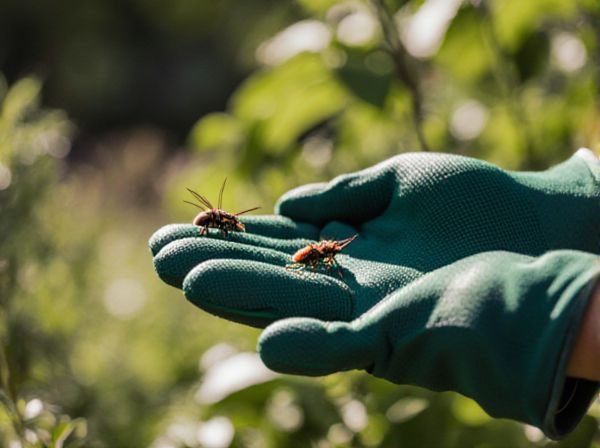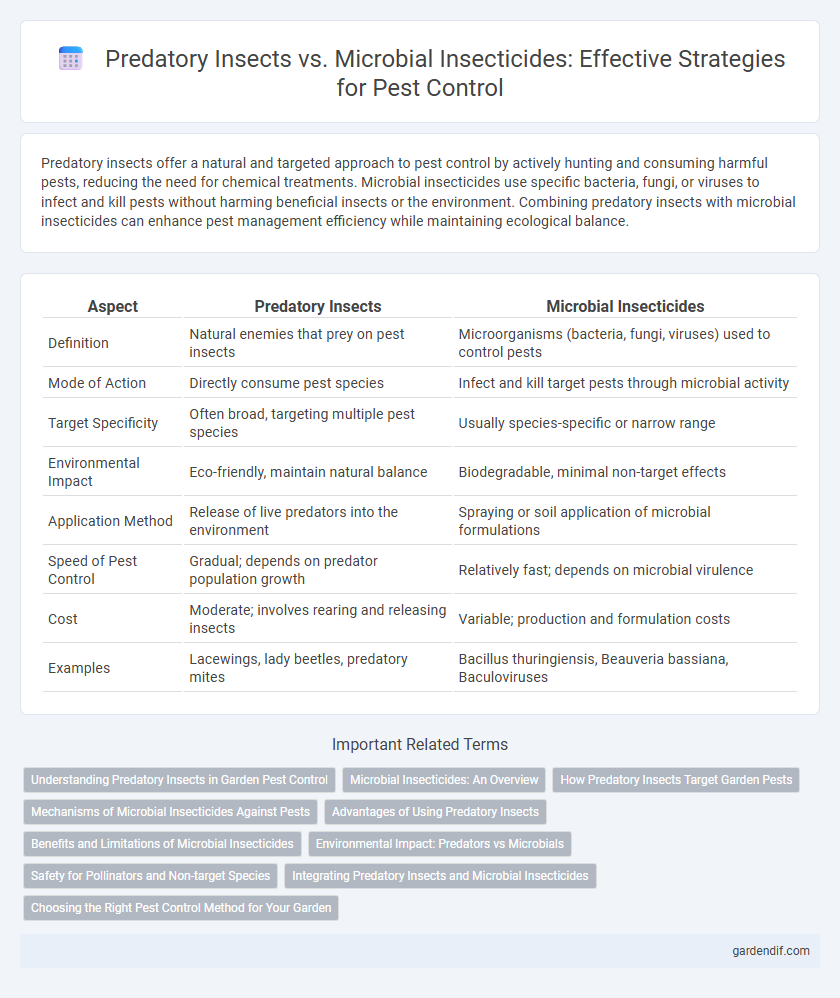
Predatory insects vs microbial insecticides Illustration
Predatory insects offer a natural and targeted approach to pest control by actively hunting and consuming harmful pests, reducing the need for chemical treatments. Microbial insecticides use specific bacteria, fungi, or viruses to infect and kill pests without harming beneficial insects or the environment. Combining predatory insects with microbial insecticides can enhance pest management efficiency while maintaining ecological balance.
Table of Comparison
| Aspect | Predatory Insects | Microbial Insecticides |
|---|---|---|
| Definition | Natural enemies that prey on pest insects | Microorganisms (bacteria, fungi, viruses) used to control pests |
| Mode of Action | Directly consume pest species | Infect and kill target pests through microbial activity |
| Target Specificity | Often broad, targeting multiple pest species | Usually species-specific or narrow range |
| Environmental Impact | Eco-friendly, maintain natural balance | Biodegradable, minimal non-target effects |
| Application Method | Release of live predators into the environment | Spraying or soil application of microbial formulations |
| Speed of Pest Control | Gradual; depends on predator population growth | Relatively fast; depends on microbial virulence |
| Cost | Moderate; involves rearing and releasing insects | Variable; production and formulation costs |
| Examples | Lacewings, lady beetles, predatory mites | Bacillus thuringiensis, Beauveria bassiana, Baculoviruses |
Understanding Predatory Insects in Garden Pest Control
Predatory insects such as lady beetles, lacewings, and predatory wasps play a crucial role in natural garden pest control by feeding on harmful pests like aphids, mites, and caterpillars. Unlike microbial insecticides, which rely on bacteria or fungi to target specific pests, predatory insects offer continuous pest suppression through direct predation and reproduction within the garden ecosystem. Integrating these beneficial insects enhances biological control, reduces chemical pesticide dependency, and promotes sustainable pest management.
Microbial Insecticides: An Overview
Microbial insecticides utilize bacteria, fungi, viruses, or protozoans to target and control pest populations, offering an environmentally friendly alternative to chemical pesticides. Bacillus thuringiensis (Bt) is the most widely researched microbial agent, producing toxins lethal to specific insect larvae while sparing beneficial insects and humans. The effectiveness of microbial insecticides depends on factors such as application timing, environmental conditions, and pest susceptibility, making them an essential component of integrated pest management.
How Predatory Insects Target Garden Pests
Predatory insects target garden pests by actively hunting and consuming harmful insects such as aphids, caterpillars, and whiteflies, reducing pest populations naturally. These beneficial insects use sensory cues to locate their prey and provide continuous pest control without chemical residues. Their effectiveness supports sustainable gardening by maintaining ecological balance and minimizing the need for microbial insecticides.
Mechanisms of Microbial Insecticides Against Pests
Microbial insecticides operate by introducing specific pathogens such as bacteria, fungi, or viruses that infect and disrupt the physiological processes of pest insects. These microorganisms produce toxins or invade the host, leading to weakened immunity and eventual mortality without harming beneficial predatory insects. The targeted mode of action and environmental safety make microbial insecticides a sustainable alternative to chemical pesticides in integrated pest management programs.
Advantages of Using Predatory Insects
Predatory insects offer targeted pest control by naturally reducing pest populations without harming beneficial organisms or the environment. Their ability to reproduce and establish sustainable populations provides long-term pest management, minimizing the need for repeated applications. Utilizing predatory insects decreases chemical residues in crops, supporting organic farming practices and promoting ecological balance.
Benefits and Limitations of Microbial Insecticides
Microbial insecticides offer targeted pest control by utilizing natural pathogens like Bacillus thuringiensis, minimizing harm to beneficial insects and reducing chemical residues. Their benefits include environmental safety, specificity to pest species, and reduced risk of resistance development compared to chemical pesticides. Limitations involve slower action, dependence on favorable environmental conditions, and limited effectiveness against a broad spectrum of insect pests.
Environmental Impact: Predators vs Microbials
Predatory insects offer an eco-friendly pest control option by naturally reducing pest populations without introducing synthetic chemicals, promoting biodiversity and maintaining ecosystem balance. Microbial insecticides, composed of bacteria, fungi, or viruses, target specific pests with minimal non-target effects but may disrupt soil microbial communities if overused. Both methods lower chemical pesticide reliance, yet predatory insects generally have a lower environmental footprint due to their self-sustaining populations and limited persistence in the environment.
Safety for Pollinators and Non-target Species
Predatory insects offer a natural pest control solution by selectively targeting harmful pests, reducing risks to pollinators and non-target species compared to microbial insecticides, which may inadvertently affect beneficial organisms. Microbial insecticides, while effective against specific pests, can pose safety concerns due to their potential impact on soil microbiota and beneficial insect populations. Employing predatory insects supports ecological balance and biodiversity, enhancing sustainable pest management with minimal adverse effects on pollinators such as bees and butterflies.
Integrating Predatory Insects and Microbial Insecticides
Integrating predatory insects and microbial insecticides enhances pest management by leveraging biological control agents with microbial pathogens to suppress pest populations effectively. Predatory insects target specific pests through direct predation, while microbial insecticides such as Bacillus thuringiensis disrupt pest larval development, creating a complementary approach that reduces reliance on chemical pesticides. This integration promotes sustainable agriculture by maintaining ecological balance and minimizing resistance development in pest species.
Choosing the Right Pest Control Method for Your Garden
Predatory insects like ladybugs and lacewings provide targeted, natural pest control by consuming harmful pests such as aphids and mites, promoting a balanced garden ecosystem. Microbial insecticides, containing bacteria like Bacillus thuringiensis, target specific pest larvae with minimal impact on beneficial insects and soil health. Selecting the right method depends on the pest type, garden size, and ecological impact, ensuring effective control while preserving biodiversity and plant health.
Predatory insects vs microbial insecticides Infographic

 gardendif.com
gardendif.com